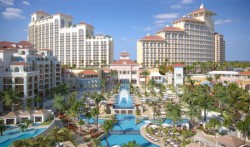By just over the first half of the year total visitor arrivals saw a slight slippage from the numbers that were recorded in 2005 with Nassau/Paradise Island and the Family Islands showing less tourist activity between the months of January and August while Grand Bahama inched ahead of the previous year’s numbers in the period.
Ministry of Tourism figures up to the month of August show that there were approximately 3.4 million total air and sea arrivals by the first port of entry to The Bahamas. This was 3.5% lower than the same period in 2005. Out of that figure, arrivals to New Providence and the Family Islands accounted for the decline while Grand Bahama reflected a 1.8% hike in tourist activity, according to the numbers released.
However for the month of August alone – for which the latest figures were released – overall air and sea arrivals were down by 6.6%. In that month For New Providence there were 228,406 visitors; 40,850 to Grand Bahama and 79,688 travelers to the Family Islands, all reflecting a 1.6%, 27% and 6.7% decline respectively.
As for cruise passengers, Nassau/Paradise Island was the only destination that recorded an increase while there were losses sustained in the number that traveled to Grand Bahama and the Family Islands.
“Sea arrivals to Nassau/P.I. for August were up because cruise arrivals for the island were up,” noted the industry information released by the Ministry of Tourism.
“Major cruise lines like Carnival Cruises, Disney Cruises and Norwegian Cruises all brought in more passengers to Nassau/ Paradise Island than they had during the same period of 2005.”
According to tourism analysts, the cruise losses sustained in the out islands were as a result of decreased activity from Norwegian Cruises and Holland America.
“Sea arrivals to Grand Bahama for August were down because cruise arrivals for the island were down,” the report said. “All of the major cruise lines like Carnival Cruises, Discovery Cruises and Royal Caribbean all brought in fewer passengers to Grand Bahama than during the same period of 2005.”
The information was provided by the Immigration Department through head counts of foreign visitors and transit arrivals to The Bahamas excluding ship crews, diplomatic personnel and returning residents. They also take no account of multiple entries made by some visitors at different ports in the country.
In recent times some tourism officials have been worried about the potential for an unfair advantage in the cruise sector’s favour as a result of a new decision by the U.S. government to extend the deadline for the requirement of American sea travelers to present passports at U.S. border crossings to June 2009 while maintaining the January 2007 implement date for air arrivals.
The U.S. is pursuing a Western Hemisphere Travel Initiative as a means of strengthening border controls.
“The cruise industry already enjoys a huge competitive advantage over the hotel sector, not incurring the same costs of operations and taxation levels that we do,” said Earl Bethel, president of the Bahamas Hotel Association at the time.
Bahamian tourism and travel officials are worried about the ultimate impact on the sector as a result of the changes.
There are also concerns about The Bahamas and the Caribbean region losing out on the impulse market as those who want to travel on a whim would also be required to produce passports upon reentry into the U.S.
The latest evaluation of economic and financial activity from the Central Bank of The Bahamas noted that total arrivals for June 2006 firmed by 3.4% in comparison with the same period a year ago, reflecting expansions in both the air and sea components, which grew by 1.7% and 4.5%, respectively. In that number, the Family Islands’ segment posted the largest gain, as an 8.4% advance in air visitors and a 17.9% surge in sea tourists resulted in a 15.4% upturn in overall arrivals.
The latest information regarding hotel performance for the month of May suggests that room revenues rose by 12.7% to $33.2 million, outpacing the $29.5 million intake in the previous year, the Central Bank report said. The majority of this improvement was attributed to the Grand Bahama market, which recorded a 24.5% advance to $4.6 million in total room revenues, on account of a 17.9% hike in the average daily room rate and a 5.6% rise in occupied room nights.
In New Providence, room revenues were also higher by 11.2%, as occupied room nights and the average daily room rate rose by 8.8% and 2.1%, respectively. A slightly lower gain of 9.8% was registered for Family Island room receipts, as the firming in average room rates offset the reduction in occupied room nights.
By: Tameka Lundy, The Bahama Journal



